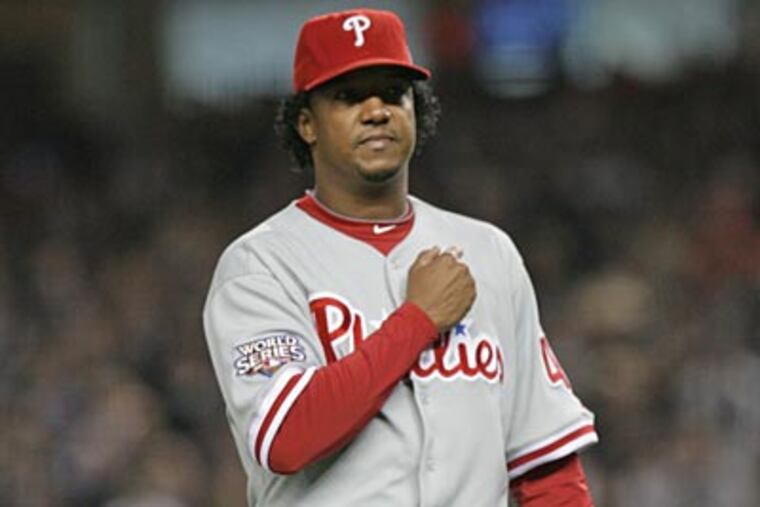Paul Hagen: A wait-and-see approach with Phillies
NEW YORK - So Ruben Amaro Jr. was sitting in the visitor's dugout at Yankee Stadium the other night, trying to calm the troubled waters. Speaking calmly, flashing the occasional soothing smile, conceding that the Phillies' offense has been "horrendous" lately but continuing to express confidence that there was no cause for alarm.

NEW YORK - So Ruben Amaro Jr. was sitting in the visitor's dugout at Yankee Stadium the other night, trying to calm the troubled waters. Speaking calmly, flashing the occasional soothing smile, conceding that the Phillies' offense has been "horrendous" lately but continuing to express confidence that there was no cause for alarm.
At a certain point the conversation began to meander. Somebody mentioned Pedro Martinez. The general manager casually said that, yes, there had been conversations with his agent. But, no, nothing was hot. No, he didn't know if Martinez was even throwing back in the Dominican Republic. No, there was no news here.
Sure enough, within hours, ESPN.com was reporting that the Phillies were discussing a comeback with Pedro. And then it was off to the races. That headline appeared on the crawl of the television shows. It became talk-show fodder. Columnists and bloggers began weighing in on the pros and cons of the Phillies bringing him back and What It All Means.
We live in an amazing age. Information can circle the globe at the speed of light.
The problem is, so can misinformation, misunderstandings and outright speculation. And the line between what's real and what's fantasy has never been more blurred.
The real question isn't even whether Martinez will rejoin the Phillies at some point. The real question is whether the Phillies' pitching, as currently constituted, is good enough to get the team back to the World Series. Assuming, of course, that the lineup recovers to become a reasonable facsimile of what it's supposed to be.
Have to get back to you on that one . . .
That Jamie Moyer was able to bounce back and scatter three hits across eight innings in last night's 6-3 Phillies win at Yankee Stadium was encouraging. Especially since the 47-year-old lefty was coming off one of the worst outings of his long career.
It also helped reinforce the invisible connection between pitching and scoring runs. Lately, Phillies starters haven't been able to anticipate a lot of run support. There was circumstantial evidence that they had begun to subconsciously feel the need to make every pitch too perfect. And that's almost always a bad thing.
Moyer had a 4-0 lead by the time he went out for the second inning and a 6-1 edge going into the third. That's living high on the hog for a Phillies pitcher in the last month or so.
"We put our game together," manager Charlie Manuel said. "We scored runs early and Moyer pitched well."
If Amaro is correct and the hitting reappears as suddenly as it vanished . . .
If J.A. Happ really is finally on the road to recovery from the left forearm strain that has sidelined him since April 16 . . .
If Joe Blanton, whose track record suggests he's better than the 1-5 record and 7.28 earned run average he'll lug into tomorrow night's start against the Twins, begins pitching closer to his career norm . . .
If Roy Halladay and Cole Hamels stay the course . . .
If Moyer doesn't start suddenly acting his age . . .
Then, yeah, the pitching just might be good enough.
Just in case, though, Amaro and his deputies will be actively exploring all trade possibilities between now and the July 31 deadline. That's a given.
Disclaimer: It appears that the Phillies don't have the prospects it would take to land an upper-echelon starter or the payroll flexibility to take on a big contract - Roy Oswalt, for example - even if the other team is only looking for salary relief.
Somewhere down the road, then, it's conceivable that they might have to consider looking into Pedro: The Sequel.
Disclaimer: It would take him some time to get into pitching shape. Martinez radiates excitement. We all remember how well he pitched at times, especially against the Dodgers in the NLCS. He also got hurt. The Phillies' understandable desire to be respectful to a future Hall of Famer played a part in their decision to yo-yo Happ and Blanton between the rotation and the bullpen during the postseason. He took the loss in decisive Game 6 of the World Series and was last seen walking out of Yankee Stadium without saying a word.
This is the point when any conversation about the Phillies pitching inevitably leads to Cliff Lee. A loud and vocal segment of the fan base has maintained a relentless cacophony on the subject ever since Lee was traded to the Mariners on the day Roy Halladay was acquired from the Blue Jays.
Unless the Phillies win the World Series, that carping will never stop. The thing is, though, time travel hasn't been invented. There's no way to go back and undo the deal, even if Amaro were so inclined.
Whether or not the Phillies rotation is good enough is a stimulating debate, with answers to be revealed over the next few months. Continuing to bitch about Lee being gone, on the other hand, is just a waste of time.
And don't hold your breath waiting for Pedro to come back, either.
Send e-mail to hagenp@phillynews.com